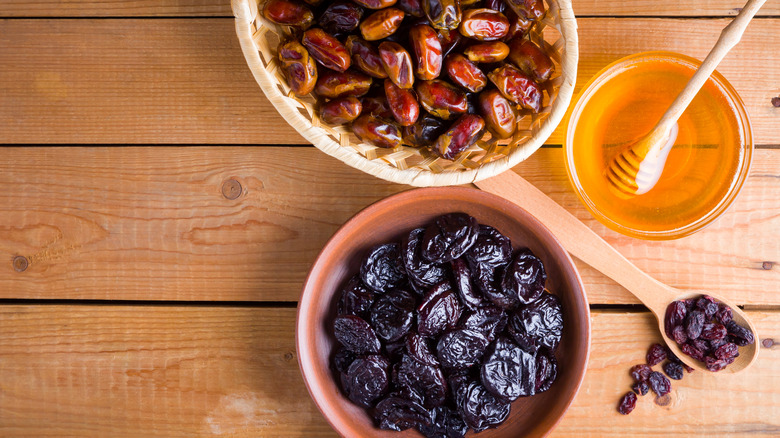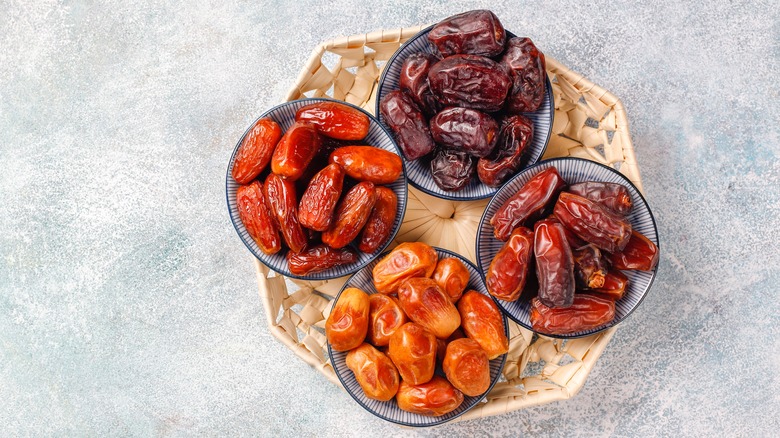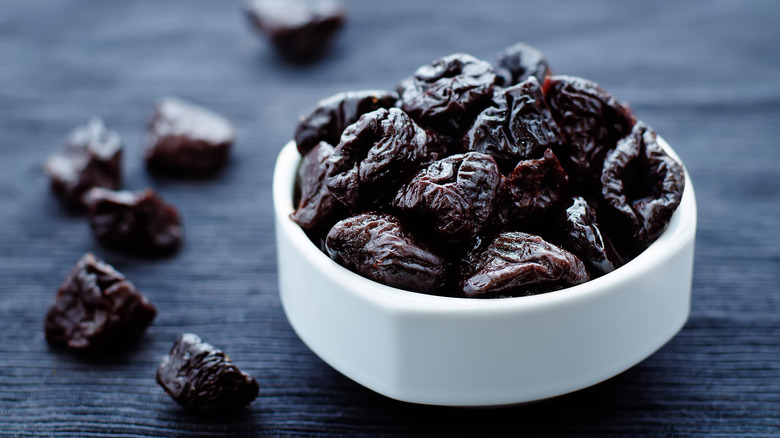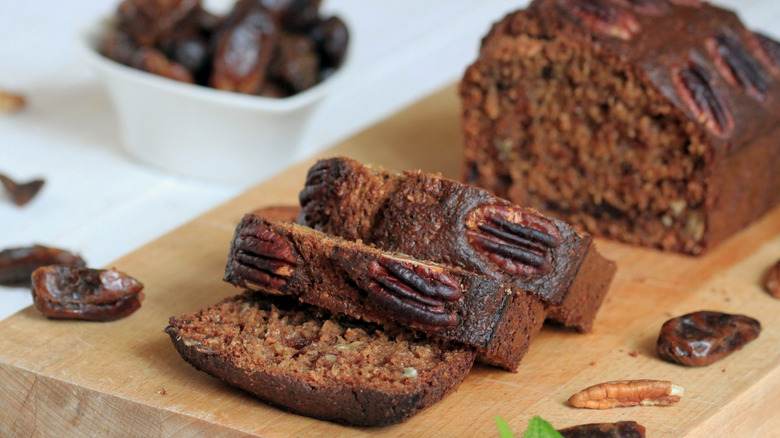What's The Difference Between Dates And Prunes?
There are few greater culinary surprises than biting into a golden brown, warm-from-the-oven chocolate chip cookie only to realize the chocolate chips are actually raisins (cue your inner four-year-old who throws a frustration fit). Or maybe you've purchased beautiful orange tomatoes at the store before discovering you've actually brought home persimmons. There are plenty of doppelgänger foods out there and while well-seasoned cooks can differentiate a from b by a mere glance, those newer to the kitchen may be guilty of unintentionally swapping sugar for salt or cornstarch for flour.
Although not quite as mistaken as sweet potatoes and yams, prunes and dates share some features that may leave dried fruit novices scratching their heads as to which one is which, or at the very least, if they can be interchanged. While they are both delightful to eat on their own, prunes and dates do have some significant differences that make each unique.
What is a date?
Brown, oblong, and about an inch long, dates are the fruit of the date palm tree. Plentiful in the Middle East, North Africa, Mexico, California, and other warm locales, dates are fruits that are usually dried before eaten and are packed with natural sugary sweet goodness. Dates have a thin, edible skin that gives way to a very soft, almost gooey fruit center that surrounds an elongated pit that should be discarded. They're often used in cooking and baking but can also be added to milkshakes or smoothies, or eaten out of hand.
There are several different types of dates but the kind most often seen in American markets is the Medjool. Medjool dates are plump and succulent with a flavor reminiscent of maple syrup. They are excellent for stuffing with cheese or wrapping in bacon and baking for a delicious appetizer. In total, there are over 200 different types of dates, which range in color from golden yellow to coffee-hued, and they are as sweet as honey, brown sugar, and caramel. Despite their high sugar content, dates are a healthier alternative to table sugar as they contain plenty of vitamins and minerals like iron, magnesium, and potassium.
What is a prune?
All prunes are plums – specifically, plums that have been pitted and dried. They are sweet in their own right but are noticeably less so than dates. You might notice a subtle sharpness when you pop a prune into your mouth; Plums have a naturally tart skin that translates into their dried counterparts. Prunes are usually a little larger than dates, and they are round, however, they wrinkle up quite a bit when they are dried, so sometimes the shape looks more wonky than perfectly spherical.
They are very dark in color and almost appear black, with an equally dark interior that is soft, fleshy, and distinctly chewy. The chew isn't so gummy that prunes are difficult to eat. On the contrary, it offers a pleasant texture. Even though there are a number of different types of plums available, prunes normally aren't labeled according to their varietal, however, almost all plums in America are the La Petite d'Agen plum which originated in France.
Because prunes are not as sweet as dates, they may be more agreeable to eating alone as a snack. In cooking, prunes are sometimes used in poultry stuffing, used to make cakes, are made into juice, and make a nice alternative to the normal dried fruits found on cheese boards like apricots and cherries. When it comes to dried fruits, dates and prunes are two of the best that act as two of nature's candies.
Are prunes and dates interchangeable?
Depending on your recipe, there are times when you can swap one of these dried fruits for the other. In baking recipes such as bread and cakes, many recipes will call for dates because they are so sweet, but if all you have are prunes, the substitution should be fine, albeit, a little less sugary. In savory stuffings that use prunes, you might want to stay away from subbing dates because of the high sugar content. In a case like this, it may be better to substitute dried apricots, cherries, or cranberries for the prunes.
If you try to substitute prunes for dates in a stuffed appetizer recipe (i.e. bacon-wrapped dates with parmesan) you may find that the flesh of the prune is not as pliable as dates. Since dates are gooey and soft, they are much easier to stuff with cheese or nuts, but prune's chewy interior is not ideal for stuffing. In this case, it's best to go with what the recipe specifies. When it comes to dried fruits, dates and prunes are two of the best that act as two of nature's candies. It's worth experimenting with both in your kitchen.



